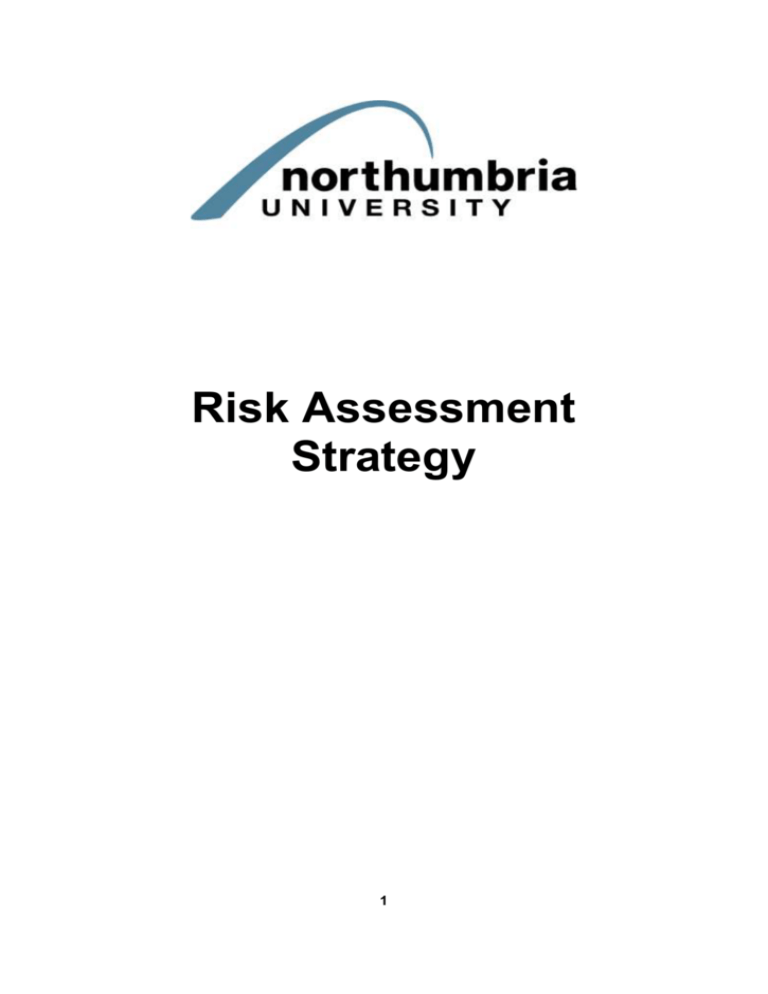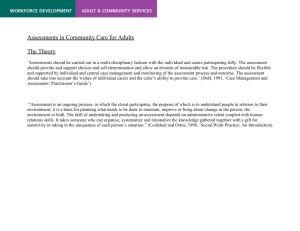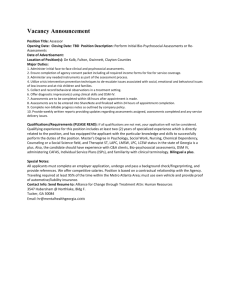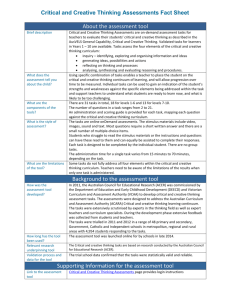Risk Assessment Documentation
advertisement

Risk Assessment Strategy 1 Risk Assessment Strategy The purpose of this strategy document is to detail the arrangements that Northumbria University has developed to ensure implementation of the Management of Health & Safety at Work Regulations 1999 and the University Health & Safety Policy. Legal Requirements The Health and Safety at Work etc Act 1974 places general duties on employers to ensure the health, safety and welfare of employees and others who may be affected by it acts or omissions. Specifically the Management of Health and Safety at Work Regulations 1999 require employers to make a suitable and sufficient written assessment of risk to employees and anyone else affected by work activities. Risk Assessment Documentation The University has standard forms to be used for the recording of all risk assessments which are available on the Health & Safety web pages. Legal Responsibilities for Risk Assessment Board of Governors As the employer, the Board of Governors accepts ultimate responsibility for health and safety and is committed to ensuring that these responsibilities are fully discharged throughout the University. Chief Operating Officer The Board of Governors delegates operational responsibility to the Chief Operating Officer who has overall responsibility for health and safety within the University and provide the link between the strategic aims of the Board and the implementation of the University’s Health & Safety programme. In order to discharge this responsibility, the Chief Operating Officer demonstrates a commitment to pursuing the highest possible standards of health and safety by integrating the principles of risk management into the day-to-day activities of the University and ensuring that a systematic programme of risk assessment is in place. Executive Deans/Directors of Service Each Executive Dean and Director is responsible for ensuring that health and safety standards in their Faculty or Service Area are of the highest standard possible and that risk assessments are undertaken for teaching, research and business activity by members of staff designated to do so. They must ensure that risk assessments are implemented and that all employees for whom they have responsibility are informed and trained on the information contained in them. The assessments should be reviewed as necessary, usually following major refurbishment, change of activity or following an accident and at least annually. Technical Support Teams Technical Support Teams are responsible for ensuring that risk assessments are carried out on the plant, equipment materials and substances that they are responsible for and that appropriate control measures are implemented. 2 All Employees All employees, including non-permanent employees and where applicable agency workers will be responsible for adhering to the standards identified in the risk assessments and also complying with all safe working practices. Head of Health, Safety & Sustainability The Head of Health, Safety and Sustainability is responsible for advising on technical matters, and for providing training to all managers involved in the risk assessment process. Risk Assessment Process Establish a Faculty or Service Department Health & Safety Group. As identified in the University Health & Safety Policy, the Executive Dean or Director should ensure that a Health & Safety Group is formed of staff who will be involved in the process of undertaking risk assessments. The purpose of each group will be to develop and produce comprehensive risk assessments that are suitable and sufficient for their specific work area. A cross section of staff involvement in the group is important as this will provide valuable assistance to Managers in the detail of operational arrangements and the practical implications of any identified control measures. Involvement of Trade Union representatives in the early stages of the risk assessment process should be positively considered. As well as bringing an employee perspective to the process, involvement will also assist in demonstrating formal consultation and add credibility to the process. Obtain Background Supporting Information. It is sometimes easier to initiate the process of undertaking risk assessments in a working group if there is some information relevant to the task available for group members. At the first meeting of the group the availability of risk assessment documentation undertaken previously, will be of great assistance, help to put the task into context and remove the feeling of starting with a ‘blank sheet of paper’ There are generic risk assessments for a number of activities on the University Health & Safety web page to use as reference. The most senior manager involved in the working group should take responsibility for gathering background information prior to the first meeting which may include the following: Any previous risk assessments relating to the Faculty or service area. Details of working practices, operational procedures or internal codes of practice. This may include method statements or quality procedures. Taking documentation of this type into account at this stage, as well as informing the overall process can reduce the amount of duplicated information that needs to be included in risk assessments by cross referencing the risk assessment with the existing code of practice or operational procedure. 3 Authoritative sources of information such as legislation relevant to the work, approved codes of practice and guidance provided by Government or Health and Safety Executive sources. Standards documents such as those produced by Universities and Colleges Employers Association (UCEA) etc It may also be useful to take into account the accident, injury and near miss history for the particular Faculty or service area. Undertaking Risk Assessments Identify activities with hazard potential: These should be recorded on Hazard Identification form (appendix 1). This list will help prioritise which activities are to be risk assessed. To assist with this process an Aide Memoire has been developed identifying significant risk areas – (appendix 2) However it should be noted that this list is not exhaustive and is intended as a guide only. Identify the Activity/Equipment/Materials etc to be assessed: This should be recorded in the first column of the Risk Assessment Form (appendix 3). For example a member of the office staff or a Technician may be identified as needing to use stepladders as part of their work. The activity is ‘use of ladders’ and should be recorded in the first column of the risk assessment form. Identify hazards and risks associated with work activities: A hazard is something with the potential to cause harm. So based on the example above – use of stepladders, the hazard may be:i) Fall from a height due to incorrect use of ladders – possible serious injury ii) Failure of ladders during use – possible serious injury This should be recorded in the hazard column of the risk assessment form. Identify those people at risk: Not only will this deal with employees, but also consideration needs to be given to students, visitors, contractors and other members of the public. Consideration must be given to the number of staff who might be harmed by a particular hazard and also to the number of students and visitors who might be harmed. Additional consideration also needs to be given to those at greater risk such as young people, those with a disability, new and expectant mothers or any other person who has reported a medical condition which may be made worse by their work activity e.g. an employee who may suffer from asthma or stress or someone with an existing back condition that could potentially be made worse as a consequence of manual handling activities. These individuals will require a specific risk assessment to be completed. Risk Rating: Using the risk ratings in Appendix 4 the assessor must decide the likelihood and severity of the hazard, before control measures are in place in order to identify the level of risk. For example:Use of stepladders every day, staff have no training in how to work safely on them and no visual inspections carried out before use. 4 - Likelihood of accident = very likely and would score a 5 on the risk matrix Severity of accident = major injury and would score an 4 on the risk matrix The likelihood should then be multiplied by the severity, 5 x 4=20, and then using the risk calculator (appendix 4) decide whether or not the risk is acceptable. RED AMBER GREEN Unacceptable risk Needs attention and control measures to reduce the risk Acceptable Identify suitable and sufficient control measures: Knowledge of how tasks are actually carried out is vital as employees sometimes develop ways of working that Managers and Supervisors are unaware of and may differ from previously agreed methods of work. Employee involvement at this stage is very important. If existing control measures are not adequate, the question becomes ‘what should be done to reduce the risk sufficiently?’ The control measures should then be recorded on the risk assessment form. Final Risk Analysis: When suitable & sufficient control measures have been agreed and implemented then the risk rating process, as detailed above, should be considered again and the result recorded on the form. Signing Off Risk Assessments: Once the working group has completed the risk assessment exercise described above, the Course Leader or Senior Manager leading the risk assessment group must sign off the documentation. The Senior Manager must also sign off the assessment and should be aware that by doing so they are responsible for ensuring employees work within the control measures. Managers and Senior Managers are also responsible for ensuring that there are adequate resources allocated to implement the controls identified following the risk assessment exercise. Inform Staff: The risk assessment process must not be a paper exercise. Course Leaders and Senior Managers must ensure that all employees are aware of the hazards and risks associated with the activities they undertake and are trained and competent in the application of the control measures identified in the risk assessment. Relevant risk assessments must be incorporated into the induction process for new employees and employees undertaking new duties for the first time. Supervisory staff must also be fully aware of the requirements identified in the risk assessments, as they are responsible for ensuring that employees undertake their work activities in a manner that complies with the risk assessment. Review: This should be on no less than an annual basis and can be simply changing the date on the document and signing them off. If however following an accident or as the result of the introduction of a new or different piece of work equipment or where the manner in which a work task fundamentally changes; then that risk assessment must be updated to reflect any changes in how the task will be undertaken. 5 Risk Assessment Training for Working Groups For those staff tasked with carrying out risk assessments, it is important that they have an understanding of the concept of risk assessment and training will be provided by the Head of Health, Safety & Environment. The training will cover: The legal requirements of risk assessment. Explanation of the University Risk Assessment Strategy. Identifying hazards and significant risks. Developing suitable control measures. Recording risk assessments and the use of standard documents. Generic Risk Assessments A number of generic risk assessments have been developed to assist Faculties and departments with this process. However it must be noted that they are generic and should be tailored to suit individual workplaces. Assessments include: 1. 2. 3. 4. 5. Generic Office Risk assessment Generic Woodwork Studio Activities Generic Bricklaying Activities Generic Lone Working Generic Working at Height Please follow this link to access the assessments http://www.northumbria.ac.uk/sd/central/campus/hse/healthandsafety/riskassess/?vi ew=Standard Revised 05 January 2015 Head of Health Safety & Sustainability 6








